From Invasive Species to Sustainable Nutrition: Safety, Nutritional, and Consumer Perception Study on Faxonius limosus in Serbia
Abstract
1. Introduction
2. Materials and Methods
2.1. Sampling
2.2. Determination of Safety and Nutritional Quality
2.2.1. Heavy Metals
2.2.2. Biogenic Amines
2.2.3. Macro- and Micro-Minerals
2.2.4. Chemical Composition
2.2.5. Amino Acid Composition
2.2.6. Fatty Acid Composition
2.2.7. Statistical Analysis
2.3. Consumer Survey
2.4. Ethical Statement
3. Results and Discussion
3.1. Determination of Safety and Nutritional Quality
3.1.1. Heavy Metals
3.1.2. Biogenic Amines
3.1.3. Macro- and Micro-Minerals
3.1.4. Chemical Composition
3.1.5. Amino Acid Profile
3.1.6. Fatty Acid Profile
3.2. Consumer Survey
3.2.1. Socio-Demographic Characteristics—Spearman’s Rank Correlation Coefficients Between Q1 and Q7
| Question Number | Socio-Demographic Characteristics | n | Share (%) |
|---|---|---|---|
| Q1 | Gender | ||
| Male | 82 | 26 | |
| Female | 233 | 74 | |
| Q2 | Age | ||
| 18–24 | 40 | 12.70 | |
| 25–34 | 144 | 45.71 | |
| 35–44 | 69 | 21.90 | |
| 45–64 | 60 | 19.05 | |
| >65 | 2 | 0.63 | |
| Q3 | Education | ||
| Elementary | 0 | 0 | |
| Secondary | 64 | 20.3 | |
| Postsecondary | 251 | 79.7 | |
| Q4 | Employment | ||
| Volunteer | 2 | 0.6 | |
| Student | 32 | 10.2 | |
| Unemployed | 11 | 3.5 | |
| Employed | 263 | 83.5 | |
| Pensioner | 3 | 1 | |
| Other | 5 | 1.6 | |
| Q5 | Family structure | ||
| I live alone | 79 | 25.1 | |
| I am married and live with my partner without children | 28 | 8.9 | |
| I am under 27 years old and live with my partner and child/children | 95 | 30.2 | |
| I am 27 years or older and live with my partner and child/children | 1 | 0.3 | |
| Multigenerational family | 58 | 18.4 | |
| Other | 54 | 17.1 | |
| Q6 | Place of residence | ||
| Village | 16 | 5.1 | |
| Town | 21 | 6.7 | |
| City | 278 | 88.3 | |
| Q7 | Does the Danube River flow through your place of residence? | ||
| Yes | 251 | 79.7 | |
| No | 64 | 20.3 | |
3.2.2. Respondents’ Exposure to Science—Spearman’s Rank Correlation Coefficients Between Q12 and Q26
3.2.3. Perception and Awareness of Biodiversity and Invasive Species in Serbia—Spearman’s Rank Correlation Coefficients Between Q31 and Q37
3.2.4. Consumer Attitude Towards River and Crayfish Products—Spearman’s Rank Correlation Coefficients Between Q40 and Q45
3.2.5. Correlation Between Socio-Demographic Characteristics and Respondents’ Engagement in Science
3.2.6. Correlations Between Socio-Demographic Characteristics and Perception and Awareness of Biodiversity and Invasive Species in Serbia
3.2.7. Correlation Between Socio-Demographic Characteristics and Consumer Attitude Towards River and Crayfish Products
4. Conclusions
Author Contributions
Funding
Data Availability Statement
Conflicts of Interest
References
- Díaz, S.; Settele, J.; Brondízio, E.; Ngo, H.; Guèze, M.; Agard, J.; Arneth, A.; Balvanera, P.; Brauman, K.A.; Butchart, S.H.M.; et al. Global Assessment Report on Biodiversity and Ecosystem Services; IPBES Secretariat: Bonn, Germany, 2019. [Google Scholar]
- Zorić, K.; Atanacković, A.; Ilić, M.; Csányi, B.; Paunović, M. The spiny-cheek crayfish Faxonius limosus (Rafinesque, 1817) (Decapoda: Cambaridae) invades new areas in Serbian inland waters. Acta Zool. Bulg. 2020, 72, 623–627. [Google Scholar]
- Karaman, I.; Machino, Y. Occurrence of the spiny-cheek crayfish (Orconectes limosus) and the Chinese mitten crab (Eriocheir sinensis) in Serbia. Crayfish News 2004, 26, 19–20. [Google Scholar]
- Lipták, B.; Vitázková, B.; Stloukal, E. First record of the spiny-cheek crayfish (Orconectes limosus) in the Serbo-Romanian Tamiš River. Freshw. Crayfish 2013, 19, 229–232. [Google Scholar]
- Trichkova, T.; Todorov, M.; Kenderov, M.; Hubenov, Z.; Botev, I.; Stefanov, T.; Jurajda, P. Invasive Alien Species of Benthic Macroinvertebrates and Fish in the Bulgarian Sector of the Danube River—Results of the Joint Danube Survey 4 (JDS4). Water 2022, 14, 2299. [Google Scholar] [CrossRef]
- CABI Digital Library. Available online: https://www.cabidigitallibrary.org/doi/10.1079/cabicompendium.72033 (accessed on 4 July 2025).
- Exotic Zoo. Available online: https://www.exotic-zoo.info/crayfish-species--part-4.html (accessed on 4 July 2025).
- Kouba, A.; Petrusek, A.; Kozák, P. Continental-wide distribution of crayfish species in Europe: Update and maps. Knowl. Manag. Aquat. Ecosyst. 2014, 413, 05. [Google Scholar] [CrossRef]
- Filipová, L. Distribution and Genetic Variation of Invasive Crayfish of the Genus Orconectes. Master’s Thesis, Charles University in Prague, Prague, Czechia, September 2008. [Google Scholar]
- Panteleit, J.; Keller, N.S.; Diéguez-Uribeondo, J.; Makkonen, J.; Martín-Torrijos, L.; Patrulea, V.; Pîrvu, M.; Preda, C.; Schrimpf, A.; Pârvulescu, L. Hidden sites in the distribution of the crayfish plague pathogen Aphanomyces astaci in Eastern Europe: Relicts of genetic groups from older outbreaks? J. Invertebr. Pathol. 2018, 157, 117–124. [Google Scholar] [CrossRef]
- European Commission. EASIN—European Alien Species Information Network. Available online: https://easin.jrc.ec.europa.eu/spexplorer/species/factsheet/R10443 (accessed on 4 July 2025).
- Hromiš, N.; Popović, S.; Šuput, D.; Pantić, J.; Rakita, S.; Tomičić, Z.; Čabarkapa, I. Valorisation of shell of invasive crayfish from Danube River (Faxonius limosus): Protein extraction and characterization. Food Feed. Res. 2024, 51, 143–153. [Google Scholar] [CrossRef]
- Soto, I.; Ahmed, D.A.; Beidas, A.; Oficialdegui, F.J.; Tricarico, E.; Angeler, D.G.; Haubrock, P.J. Long-term trends in crayfish invasions across European rivers. Sci. Total Environ. 2023, 867, 161537. [Google Scholar] [CrossRef]
- Lazarević, J.; Čabarkapa, I.; Rakita, S.; Banjac, M.; Tomičić, Z.; Škrobot, D.; Tešanović, D. Invasive crayfish Faxonius limosus: Meat safety, nutritional quality and sensory profile. Int. J. Environ. Res. Public Health 2022, 19, 16819. [Google Scholar] [CrossRef]
- Śmietana, N.; Panicz, R.; Sobczak, M.; Śmietana, P.; Nędzarek, A. Spiny-cheek crayfish, Faxonius limosus (Raf-inesque, 1817), as an alternative food source. Animals 2020, 11, 59. [Google Scholar] [CrossRef]
- Śmietana, N.; Panicz, R.; Sobczak, M.; Nędzarek, A.; Śmietana, P. Variability of elements and nutritional value of spiny-cheek crayfish (Faxonius limosus, Rafinesque, 1817): Variability of elements and nutritional value of F. limosus. J. Food Compos. Anal. 2020, 94, 103656. [Google Scholar] [CrossRef]
- Stanek, M.; Borejszo, Z.; Dąbrowski, J.; Janicki, B. Impact of sex and size range on fat, cholesterol content, and fatty acid profiles in edible tissues of spiny-cheek crayfish (Orconectes limosus Raf.) from Lake Goplo (Poland). Fish. Aquat. Life 2013, 21, 259–270. [Google Scholar]
- Śmietana, N.; Śmietana, P.; Drozłowska, E.; Łopusiewicz, Ł. The influence of lactic acid bacteria fermentation on the bioactivity of crayfish (Faxonius limosus) meat. Fermentation 2023, 9, 66. [Google Scholar] [CrossRef]
- Tacon, A.G.; Metian, M. Fish matters: Importance of aquatic foods in human nutrition and global food supply. Rev. Fish. Sci. 2013, 21, 22–38. [Google Scholar] [CrossRef]
- Zhang, Y.; Yang, B.; Yang, L.; Jiang, S.; Lu, J.; Lin, L. Comparison of the nutritional qualities of the pond, rice-field and wild crayfish (Procambarus clarkii) meat. Food Chem. Adv. 2023, 2, 100272. [Google Scholar] [CrossRef]
- Wang, S.; Luo, L.; Zhang, R.; Guo, K.; Zhao, Z. The biochemical composition and quality of adult Chinese mitten crab Eriocheir sinensis reared in carbonate-alkalinity water. Foods 2024, 13, 362. [Google Scholar] [CrossRef]
- Wu, J.; Zhu, H.; Li, C. Potential sources of novel proteins suitable for use as ingredients in 3D food printing, along with some of the food safety challenges. Int. J. Gastron. Food Sci. 2024, 37, 100983. [Google Scholar] [CrossRef]
- Zhang, W.; Boateng, I.D.; Xu, J. Novel marine proteins as a global protein supply and human nutrition: Extraction, bioactivities, potential applications, safety assessment, and deodorization technologies. Trends Food Sci. Technol. 2024, 143, 104283. [Google Scholar] [CrossRef]
- Food and Agriculture Organization of the United Nations. The State of Food Insecurity in the World, 2013: The Multiple Dimensions of Food Security; FAO: Rome, Italy, 2013. [Google Scholar]
- Lazăr, N.N.; Simionov, I.A.; Petrea, Ș.M.; Iticescu, C.; Georgescu, P.L.; Dima, F.; Antache, A. The influence of cli-mate changes on heavy metals accumulation in Alosa immaculata from the Danube River Basin. Mar. Pollut. Bull. 2024, 200, 116145. [Google Scholar] [CrossRef]
- Joint Danube Survey | ICPDR—International Commission for the Protection of the Danube River. Available online: https://www.icpdr.org/tasks-topics/topics/water-quality/joint-danube-survey (accessed on 27 September 2023).
- Larson, E.R.; Olden, J.D. Field sampling techniques for crayfish. In Biology and Ecology of Crayfish, Longshaw, M., Stebbing, P., Eds.; CRC Press: New York, NY, USA, 2016; pp. 287–324. [Google Scholar]
- ISO 14082:2008; Determination of Trace Elements—Determination of Lead, Cadmium, Zinc, Copper, Iron and Chromium by Atomic Absorption Spectrometry (AAS) After Dry Ashing. ISO: Geneva, Switzerland, 2008. Available online: https://iss.rs/en/project/show/iss:proj:20335 (accessed on 25 December 2023).
- Eerola, S.; Hinkkanen, R.; Lindfors, E.; Hirvi, T. Liquid chromatographic determination of biogenic amines in dry sausages. J. AOAC Int. 1993, 76, 575–577. [Google Scholar] [CrossRef]
- Tasić, T.; Ikonić, P.; Mandić, A.; Jokanović, M.; Tomović, V.; Savatić, S.; Petrović, L. Biogenic amines content in traditional dry fermented sausage Petrovská klobása as possible indicator of good manufacturing practice. Food Control 2012, 23, 107–112. [Google Scholar] [CrossRef]
- ISO 6869:2000; Animal Feeding Stuffs—Determination of the Contents of Calcium, Copper, Iron, Magnesium, Manganese, Potassium, Sodium and Zinc—Method Using Atomic Absorption Spectrometry. Institute for Standardization of Serbia: Belgrade, Serbia, 2000. Available online: https://iss.rs/en/project/show/iso:proj:33707 (accessed on 25 December 2023).
- SRPS ISO; Determination of Moisture Content (Reference Method). International Organization for Standardization: Geneva, Switzerland, 1997.
- SRPS ISO; Determination of Total Ash (Reference Method). International Organization for Standardization: Geneva, Switzerland, 1999.
- SRPS ISO; Determination of Total Fat Content. International Organization for Standardization: Geneva, Switzerland, 1998.
- SRPS ISO; Meat and Meat Products—Determination of Total Phosphorus Content—Spectrometric Method. International Organization for Standardization: Geneva, Switzerland, 1999.
- SRPS ISO; Determination of Nitrogen Content (Reference Method). International Organization for Standardization: Geneva, Switzerland, 1992.
- Omole, O.A.; Adepoju, O.B.; Moradeyo, O.T.; Okuneye, O.J.; Bello, A.A. Comparative analysis of the nutritive value of smoked, dried Procambarus clarkii (freshwater crayfish) from three Nigerian states. Asian J. Fish. Aquat. Res. 2021, 11, 39–45. [Google Scholar] [CrossRef]
- Pravilnik o Metodama Uzimanja Uzoraka i Vršenja Hemijskih i Fizičkih Analiza Radi Kontrole Kvaliteta Proizvoda od Voća i Povrća. Sl. list SFRJ 1983, 29/83. Available online: https://faolex.fao.org/docs/pdf/srb141648.pdf (accessed on 4 July 2025).
- Regulation (EU) No. 1169/2011 of the European Parliament and of the Council. Available online: https://eur-lex.europa.eu/eli/reg/2011/1169/oj/eng (accessed on 20 April 2024).
- Spackman, D.H.; Stein, W.H.; Moore, S. Automatic recording apparatus for use in the chromatography of amino acids. Anal. Chem. 1958, 30, 1190–1206. [Google Scholar] [CrossRef]
- Folch, J.; Lees, M.; Stanley, G.H.S. A simple method for the isolation and purification of total lipide from animal tissues. J. Biol. Chem. 1957, 226, 497–509. [Google Scholar] [CrossRef] [PubMed]
- ISO 12966-2:2017; Animal and Vegetable Fats and Oils–Gas Chromatography of Fatty Acid Methyl Esters–Part 2: Preparation of Methyl Esters of Fatty Acids. ISO (Institute of Standardization of Serbia): Belgrade, Serbia, 2017.
- Field, A. Discovering Statistics Using IBM SPSS Statistics, Chapter 12, 5th ed.; SAGE Publications: London, UK, 2018. [Google Scholar]
- Jubase, N.; Shackleton, R.T.; Measey, J. Public awareness and perceptions of invasive alien species in small towns. Biology 2021, 10, 1322. [Google Scholar] [CrossRef] [PubMed]
- Lucas, S.; Ropars-Collet, C.; Cuilleret, M. Can environmental or local information help manage an invasive species through consumption? J. Agric. Food Ind. Organ. 2024. [Google Scholar] [CrossRef]
- Naranjo-Guevara, N.; Fanter, M.; Conconi, A.M.; Floto-Stammen, S. Consumer acceptance among Dutch and German students of insects in feed and food. Food Sci. Nutr. 2021, 9, 414–428. [Google Scholar] [CrossRef]
- Sidiropoulou, N.; Doumpas, N.; Perrakis, E.; Tsianis, D.; Giovos, I.; Moutopoulos, D.K. Investigating consumer attitudes and market trading of edible marine invasive alien species in the Greek seafood market. Sustainability 2024, 16, 8479. [Google Scholar]
- Varol, M.; Kaya, G.K.; Alp, A. Heavy metal and arsenic concentrations in rainbow trout (Oncorhynchus mykiss) farmed in a dam reservoir on the Firat (Euphrates) River: Risk-based consumption advisories. Sci. Total Environ. 2017, 599, 1288–1296. [Google Scholar] [CrossRef]
- Commission Regulation (EU) 2021/1323 Amending Regulation (EC) No 1881/2006 as Regards Maximum Levels of Cadmium in Certain Foodstuffs (Text with EEA Relevance). Available online: http://data.europa.eu/eli/reg/2021/1323/oj (accessed on 10 August 2021).
- Commission Regulation (EU) 2021/1317 of 9 August 2021 amending Regulation (EC) No 1881/2006 as regards maximum levels of lead in certain foodstuffs (Text with EEA relevance). Off. J. Eur. Union 2021, L282, 1–7.
- Commission Regulation (EU) 2022/617 of 12 April 2022 Amending Regulation (EC) No 1881/2006 as Regards Maximum Levels of Mercury in Fish and Salt. Available online: https://eur-lex.europa.eu/legal-content/EN/TXT/?uri=CELEX:32022R0617 (accessed on 4 July 2025).
- Pravilnik o Maksimalnim Koncentracijama Određenih Kontaminenata u Hrani. Službeni Glasnik RS 2024, br. 73/2024 i 90/2024. Available online: http://demo.paragraf.rs/demo/combined/Old/t/t2024_09/SG_073_2024_009.htm (accessed on 4 July 2025).
- European Food Safety Authority (EFSA). Dietary exposure to inorganic arsenic in the European population. EFSA J. 2014, 12, 3597. [Google Scholar] [CrossRef]
- Jayakody, J.A.K.S.; Edirisinghe, E.M.R.K.B.; Senevirathne, S.A.; Senarathna, L. Total arsenic and arsenic species in selected seafoods: Analysis using high-performance liquid chromatography–inductively coupled plasma mass spectrometry and health risk assessment. J. Chromatogr. Open 2024, 6, 100172. [Google Scholar] [CrossRef]
- European Commission. Commission Regulation (EC) No 2073/2005 of 15 November 2005 on Microbiological Criteria for Foodstuffs. Off. J. Eur. Union. 2005, L388, 1–26. [Google Scholar]
- Stanek, M.; Dąbrowski, J.; Różański, S.; Janicki, B.; Długosz, J. Heavy metals bioaccumulation in tissues of spiny-cheek crayfish (Orconectes limosus) from Lake Gopło: Effect of age and sex. Bull. Environ. Contam. Toxicol. 2017, 98, 740–746. [Google Scholar] [CrossRef] [PubMed][Green Version]
- Maeaba, W.; Singh, P.; Prasad, S. Determination of microelements profile in fruits from the Solomon Islands. J. Food Compos. Anal. 2025, 141, 107284. [Google Scholar] [CrossRef]
- Ahmad, R.S.; Imran, A.; Hussain, M.B. Nutritional composition of meat. In Meat Science and Nutrition, 1st ed.; IntechOpen: London, UK, 2018; Volume 61, pp. 61–75. [Google Scholar]
- Hantoush, A.A. Nutritional value of important commercial fish from Iraqi waters. Int. J. Mar. Sci. 2015, 5, 13–22. [Google Scholar] [CrossRef]
- Rangasamy, E.; Muthu, V.L.; Dhanabalan, K.; Muniyandi, M. Determination of proximate composition on some edible crabs with special reference to nutritional aspects collected from coastal waters of Rameshwaram, Tamil Nadu. Food Chem. Adv. 2024, 4, 100686. [Google Scholar] [CrossRef]
- Fernandez, T.J.; Anandan, R.; Zynudheen, A.A. A comparative evaluation of nutritional composition of deep sea and coastal shrimp off south-west coast of India. Fish. Technol. 2018, 55, 188–196. [Google Scholar]
- Al Mamun, M.Z.U.; Haque, T.; Ahmed, M.S.; Satter, M.A.; Begum, M.; Hossen, M.S.; Moulick, S.P.; Jahan, F.; Sathee, R.A.; Rana, M.S. Nutritional evaluation of edible swimming crabs Portunus pelagicus (Linnaeus, 1758) and Portunus sanguinolentus (Herbst, 1783) from coastal area of Bangladesh. J. Agric. Food Res. 2024, 15, 100972. [Google Scholar] [CrossRef]
- Stanek, M.; Kupcewicz, B.; Dąbrowski, J.; Janicki, B. Estimation of fat content and fatty acids profile in the meat of spinycheek crayfish (Orconectes limosus Raf.) from the Brda River and the Lake Gopło. J. Cent. Eur. Agric. 2010, 11, 297–304. [Google Scholar]
- Chen, B.; Xu, X.; Chen, Y.; Xie, H.; Zhang, T.; Mao, X. Red swamp crayfish (Procambarus clarkii) as a growing food source: Opportunities and challenges in comprehensive research and utilization. Foods 2024, 13, 3780. [Google Scholar] [CrossRef]
- Stanek, M.; Borejszo, Z.; Dąbrowski, J.; Janicki, B. Fat and cholesterol content and fatty acid profiles in edible tissues of spiny-cheek crayfish, Orconectes limosus (Raf.) from Lake Gopło (Poland). Fish. Aquat. Life 2011, 19, 241–248. [Google Scholar] [CrossRef]
- Elango, R. Tolerable Upper Intake Level for Individual Amino Acids in Humans: A Narrative Review of Recent Clinical Studies. Adv. Nutr. 2023, 14, 885–894. [Google Scholar] [CrossRef] [PubMed]
- Vidosavljević, S.; Bojanić, N.; Dragojlović, D.; Stojkov, V.; Sedlar, T.; Banjac, V.; Fišteš, A. Application of Optimized Dry Fractionation Process for Nutritional Enhancement of Different Sunflower Meals. Processes 2025, 13, 255. [Google Scholar] [CrossRef]
- Simopoulos, A.P. The Importance of the Ratio of Omega-6/Omega-3 Essential Fatty Acids. Biomed. Pharmacother. 2002, 56, 365–379. [Google Scholar] [CrossRef]
- Alijani, S.; Hahn, A.; Harris, W.S.; Schuchardt, J.P. Bioavailability of EPA and DHA in Humans–A Comprehensive Review. Prog. Lipid Res. 2025, 97, 101318. [Google Scholar] [CrossRef] [PubMed]
- Li, G.; Sinclair, A.J.; Li, D. Comparison of Lipid Content and Fatty Acid Composition in the Edible Meat of Wild and Cultured Freshwater and Marine Fish and Shrimps from China. J. Agric. Food Chem. 2011, 59, 1871–1881. [Google Scholar] [CrossRef]
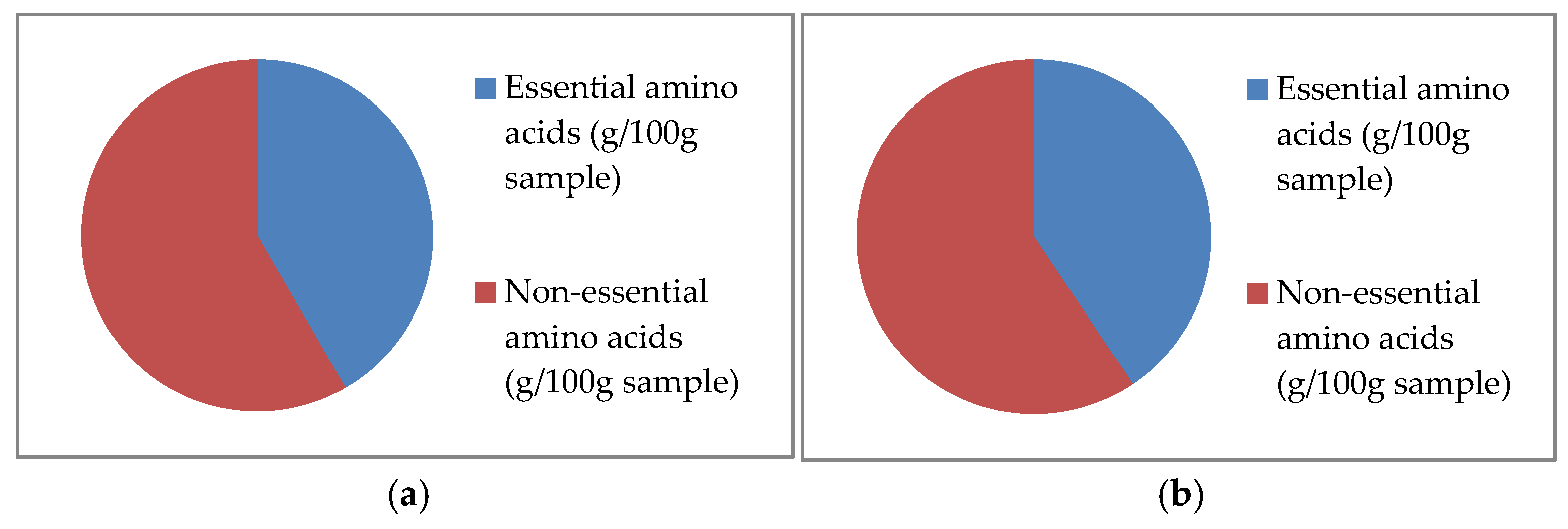
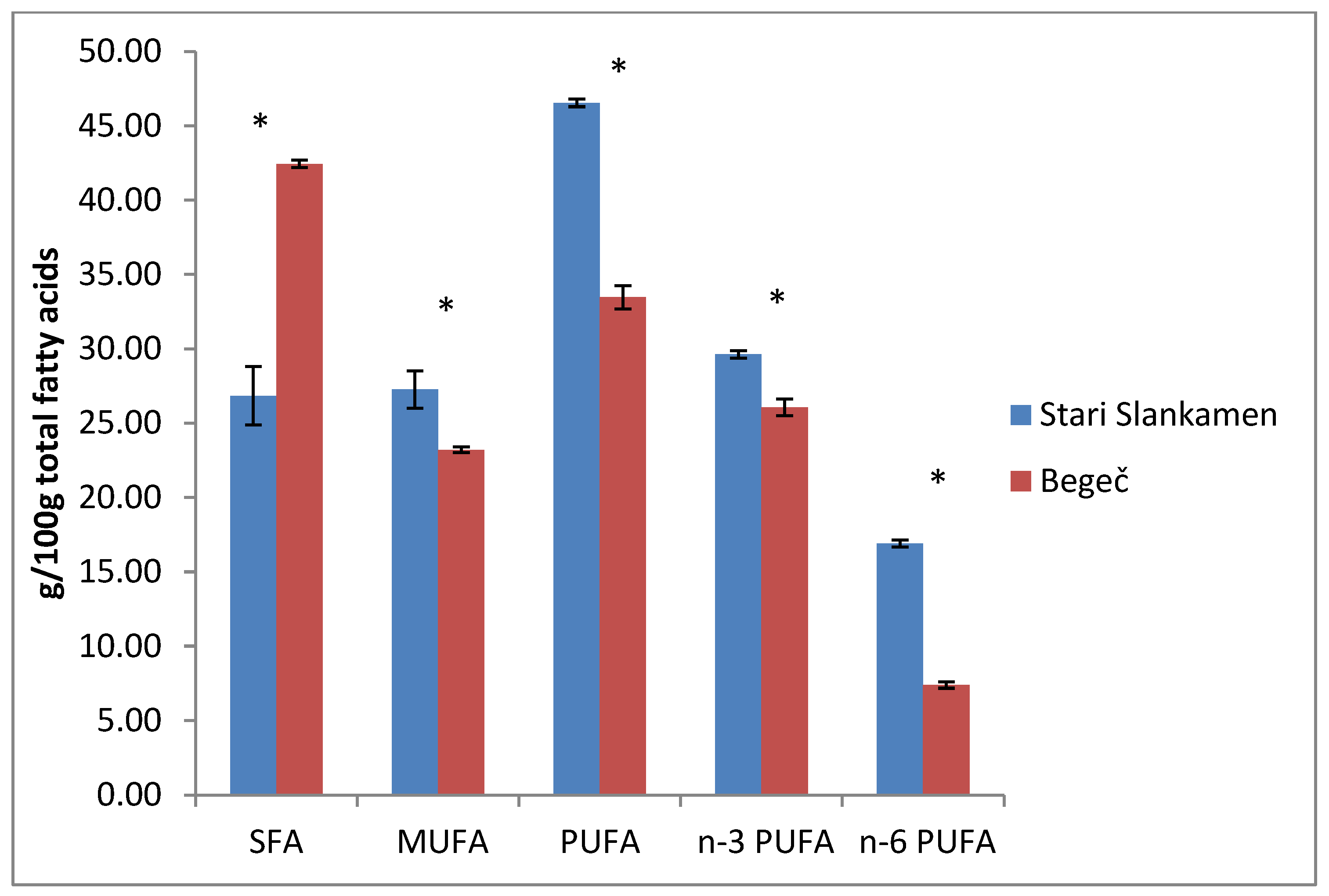
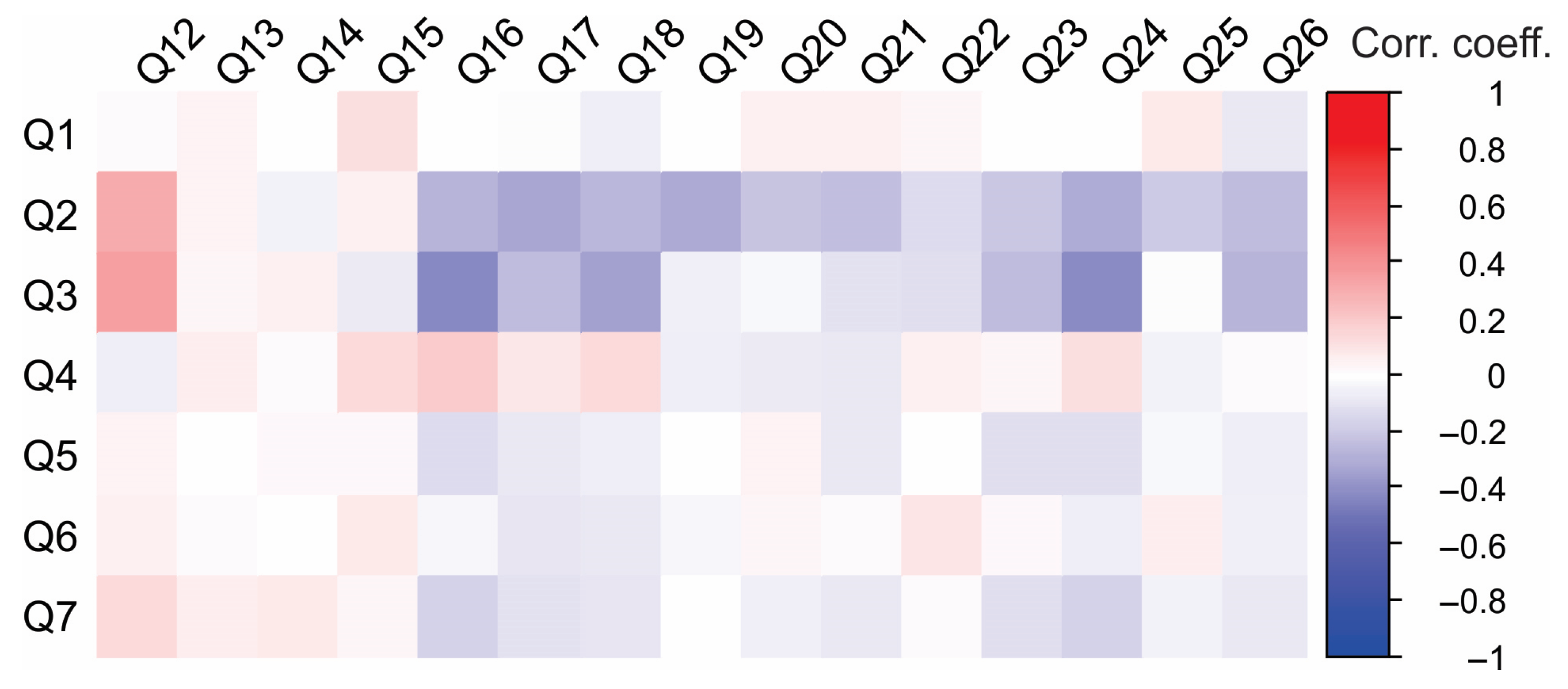
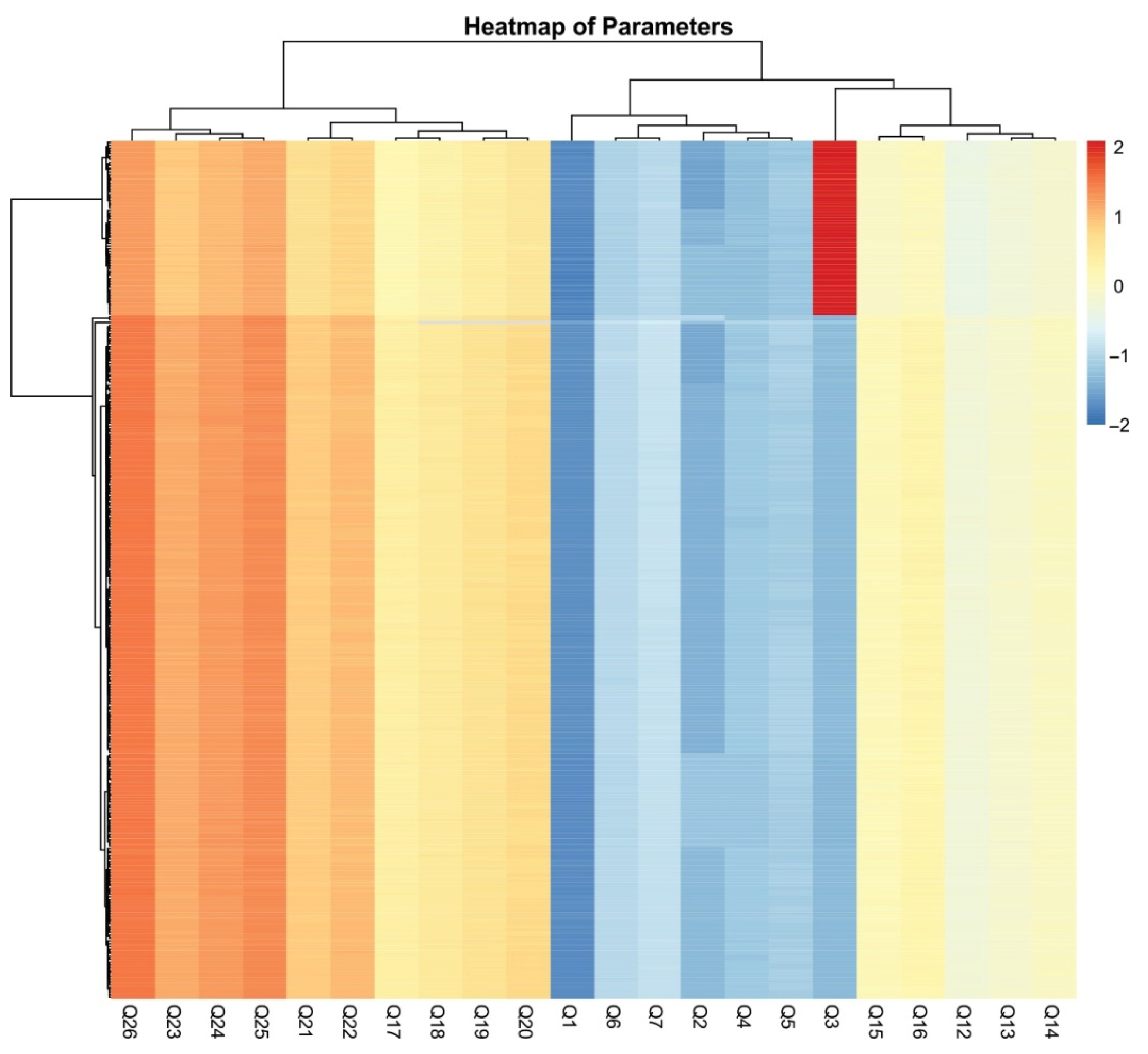
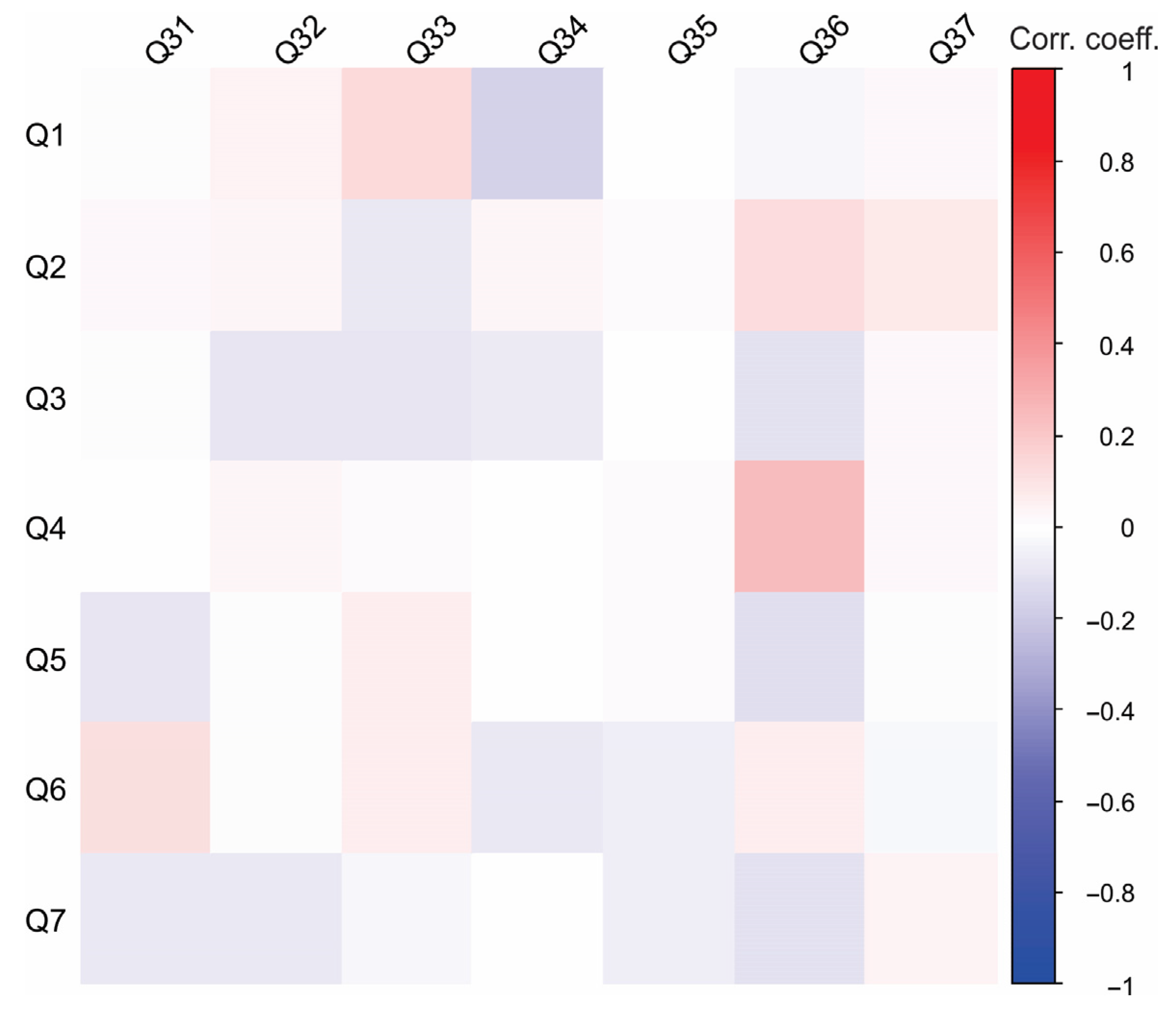
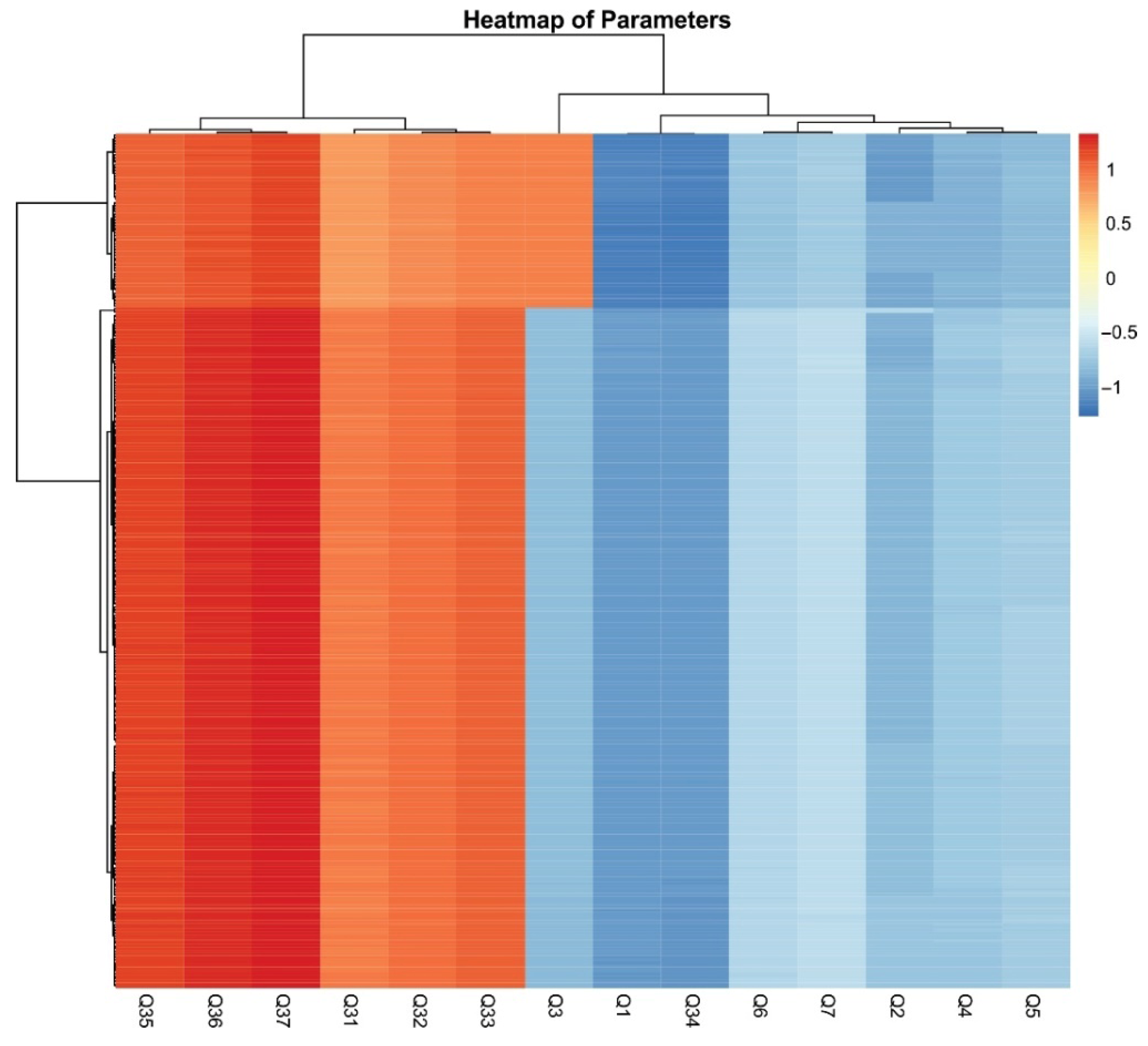
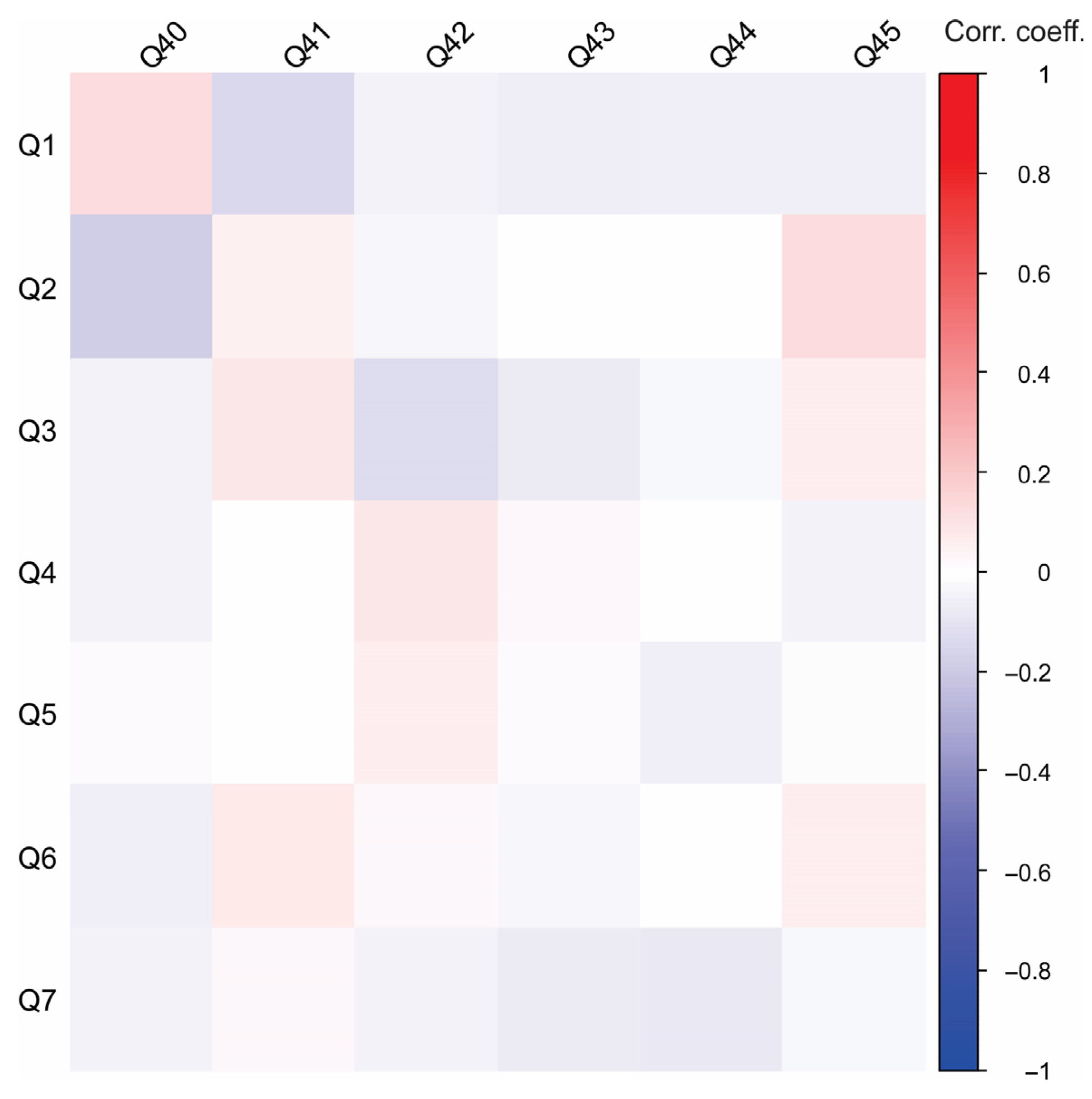
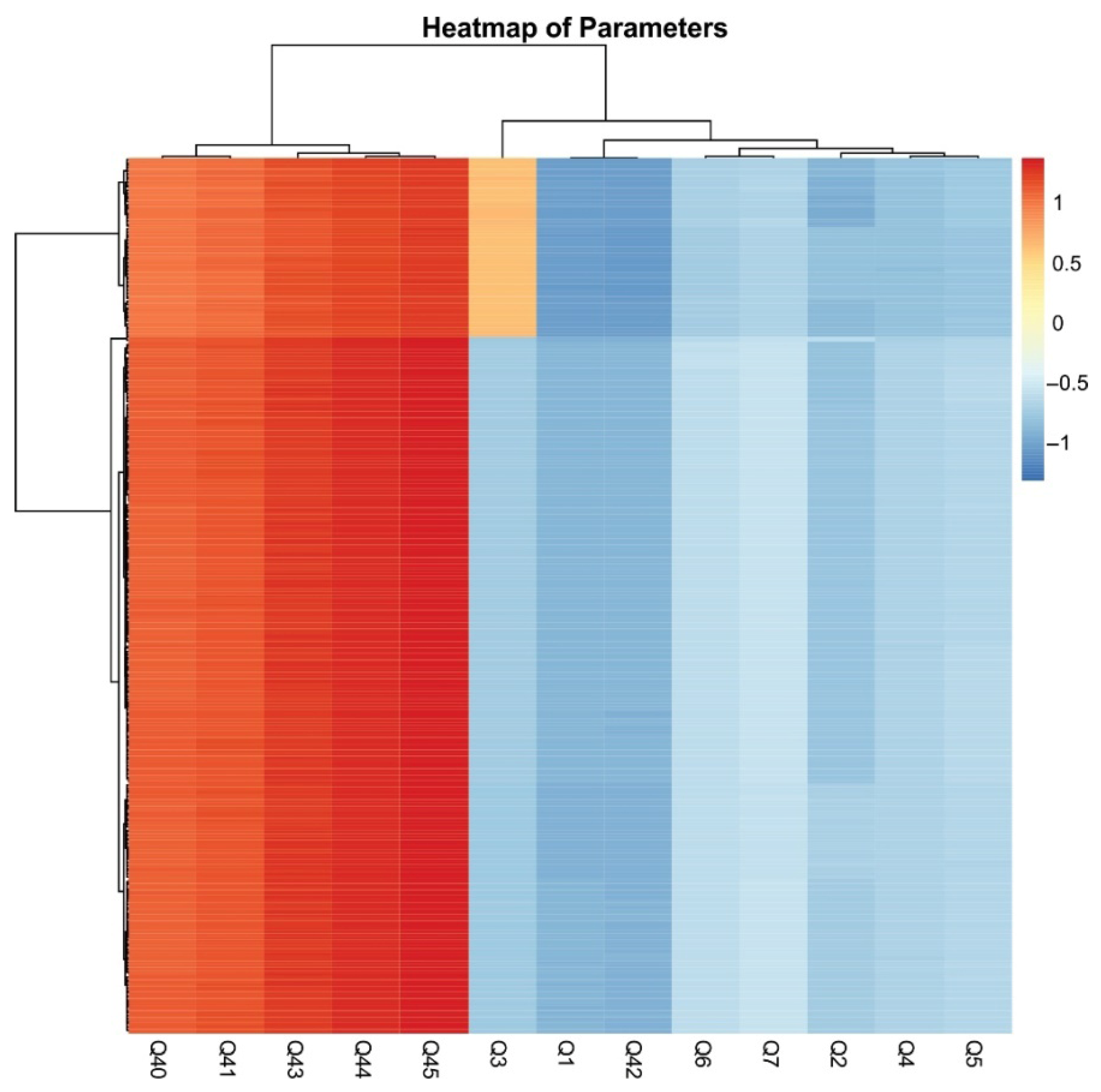
| Heavy Metals (mg/kg) | Stari Slankamen | Begeč | Maximum Legally Permitted Values (mg/kg Wet Weight) |
|---|---|---|---|
| Hg | 0.20 ± 0.07 a | 0.24 ± 0.03 a | 0.50 |
| Pb | <0.1 | <0.25 | 0.50 |
| As | <0.1 | <0.1 | currently not defined |
| Cd | <0.02 | <0.03 | 0.50 |
| Biogenic Amine (mg/kg) | Tryptamine | Phenylethylamine | Putrescine | Cadaverine | Histamine | Tyramin |
|---|---|---|---|---|---|---|
| Stari Slankamen | ND | ND | ND | ND | ND | ND |
| Begeč | ND | ND | ND | ND | ND | ND |
| Minerals (mg/kg) | SV (Slankamen) | SV (Begeč) |
|---|---|---|
| Macro-minerals | ||
| Ca | 603.15 ± 115.90 a | 597.56 ± 79.57 a |
| K | 1524.50 ± 272.82 a | 1625 ± 337.05 a |
| Mg | 229.06 ± 53.12 a | 229.72 ± 22.95 a |
| Na | 1047.57 ± 38.54 a | 1067 ± 24.64 a |
| P | 2957.50 ± 67.18 a | 3560 ± 251.59 a |
| Micro-minerals | ||
| Fe | 10.70 ± 1.39 a | 9.69 ± 2.85 a |
| Cu | 14.07 ± 1.70 a | 10.21 ± 0.83 a |
| Zn | 22.36 ± 4.56 a | 16.60 ± 1.83 a |
| Mn | 1.76 ± 0.71 a | 1.49 ± 0.76 a |
| Results of Chemical Analysis | Stari Slankamen | Begeč |
|---|---|---|
| Energy value (kJ/100 g) | 313.25 ± 16.78 a | 332.55 ± 40.37 a |
| Energy value (kcal/100 g) | 73.90 ± 3.76 a | 78.00 ± 8.49 a |
| Moisture content (%) | 80.48 ± 1.08 a | 79.48 ± 2.29 a |
| Ash content (%) | 1.33 ± 0.30 a | 1.21 ± 0.06 a |
| Protein content (%) | 16.45 ± 2.74 a | 16.90 ± 1.22 a |
| Fat content (%) | 0.20 ± 0.06 a | 0.23 ± 0.12 a |
| Total carbohydrates (%) | 1.54 ± 2.02 a | 2.19 ± 1.11 a |
| Of which sugars (%) | 1.15 a | 0.78 ± 0.34 a |
| Amino Acid (g/100 g Sample) | Stari Slankamen | Begeč |
|---|---|---|
| Threonine * | 0.75 ± 0.04 a | 0.71 ± 0.01 a |
| Valine * | 0.84 ± 0.03 a | 0.85 ± 0.01 a |
| Methionine * | 0.59 ± 0.11 a | 0.47 ± 0.00 a |
| Isoleucine * | 0.76 ± 0.04 a | 0.77 ± 0.01 a |
| Leucine * | 1.24 ± 0.03 a | 1.31 ± 0.03 a |
| Phenylalanine * | 0.77 ± 0.07 a | 0.74 ± 0.00 a |
| Histidine * | 0.32 ± 0.02 a | 0.31 ± 0.00 a |
| Lysine * | 1.61 ± 0.04 a | 1.64 ± 0.02 a |
| Aspartic acid | 1.94 ± 0.10 a | 2.07 ± 0.02 a |
| Serine | 0.86 ± 0.05 a | 0.85 ± 0.00 a |
| Glutamic acid | 2.51 ± 0.15 a | 2.77 ± 0.01 a |
| Proline | 0.42 ± 0.02 a | 0.34 ± 0.00 b |
| Glycine | 0.83 ± 0.02 a | 0.88 ± 0.00 a |
| Alanine | 0.90 ± 0.00 a | 0.97 ± 0.00 b |
| Cystine | 0.34 ± 0.02 | ND |
| Tyrosine | 0.62 ± 0.04 a | 0.60 ± 0.01 a |
| Arginine | 1.37 ± 0.03 a | 1.46 ± 0.02 a |
| TAA | 16.50 ± 0.84 a | 16.73 ± 0.03 a |
| TEAA | 6.88 ± 0.30 a | 6.78 ± 0.06 a |
| TNEAA | 9.63 ± 0.55 a | 9.93 ± 0.04 a |
| Fatty Acids | Stari Slankamen (g/100 g Total Fatty Acids) | Begeč (g/100 g Total Fatty Acids) |
|---|---|---|
| C 10:0 | 0.2 ± 0 a | 1.3 ± 0 b |
| C 12:0 | 0.1 ± 0 | ND |
| C 14:0 | 0.82 ± 0.35 a | 9.5 ± 0.1 b |
| C 15:0 | 0.66 ± 0.06 a | 1.25 ± 0.05 b |
| C15:1 | 0.52 ± 0.50 | ND |
| C 16:0 | 16.503 ± 1.46 a | 18.30 ± 0.26 a |
| C 16:1 | 4.64 ± 0.92 a | 5.25 ± 0.08 a |
| C 17:0 | 1.07 ± 0.29 a | 1.03 ± 0.03 a |
| C 17:1 | 0.33 ± 0.06 | ND |
| C 18:0 | 6.81 ± 0.21 a | 11.07 ± 0.19 b |
| C 18:1n9c | 21.14 ± 0.69 a | 17.96 ± 0.27 b |
| C 18:2n6c | 5.51 ± 0.73 a | 2.14 ± 0.01 b |
| C 18:3n3 | 1.27 ± 1.34 a | 2.13 ± 0.01 a |
| C 20:0 | 0.887 ± 0.59 | ND |
| C 20:1n9 | 1.22 ± 0.09 | ND |
| C 20:3 | 2.00 | ND |
| C 20:2n6 | 1.97 ± 0.01 a | 1.36 ± 0.02 a |
| C 20:4n6 | 9.42 ± 0.95 a | 3.9 ± 0.2 b |
| C 20:5n3 (EPA) | 24.72 ± 1.01 a | 20.05 ± 0.45 b |
| C 22:6n3 (DHA) | 3.62 ± 0.49 a | 3.9 ± 0.1 a |
| Total saturated fatty acids (SFA) | 26.84 ± 1.96 a | 42.45 ± 0.25 b |
| Total monounsaturated fatty acids (MUFA) | 27.28 ± 1.26 a | 23.21 ± 0.19 b |
| Total polyunsaturated fatty acids (PUFA) | 46.54 ± 0.26 a | 33.47 ± 0.78 b |
| Total omega-3 fatty acids (n-3 PUFA) | 29.63 ± 0.26 a | 26.08 ± 0.56 b |
| Total omega-6 fatty acids (n-6 PUFA) | 16.91 ± 0.24 a | 7.39 ± 0.22 b |
| (n-6)/(n-3) | 0.57 ± 0.01 a | 0.28 ± 0.02 b |
| (n-3)/(n-6) | 1.75 ± 0.03 a | 3.53 ± 0.03 b |
| Q2 | Q3 | Q4 | Q5 | Q6 | Q7 | |
|---|---|---|---|---|---|---|
| Q1 | −0.0328 | −0.060 | 0.0436 | 0.117 * | 0.013 | −0.024 |
| Q2 | 0.116 * | 0.311 ** | 0.032 | 0.117 * | 0.040 | |
| Q3 | −0.354 ** | 0.095 | 0.012 | 0.216 ** | ||
| Q4 | −0.100 | 0.059 | −0.170 ** | |||
| Q5 | −0.179 ** | 0.173 ** | ||||
| Q6 | −0.271 ** |
| Question Number | n | Percentage | |||||||||
|---|---|---|---|---|---|---|---|---|---|---|---|
| Q12 | Is your job in any way connected with scientific research or an institution? | ||||||||||
| Yes | 216 | 68.6 | |||||||||
| No | 99 | 31.4 | |||||||||
| Question number | How often are you in contact with science and science research with media listed down below? | ||||||||||
| n | Percentage | ||||||||||
| 1 | 2 | 3 | 4 | 5 | 1 | 2 | 3 | 4 | 5 | ||
| Q13 | Television (1–5) | 92 | 83 | 80 | 43 | 17 | 29.2 | 26.3 | 25.4 | 13.7 | 5.4 |
| Q14 | Radio (1–5) | 196 | 59 | 40 | 16 | 4 | 62.2 | 18.7 | 12.7 | 5.1 | 1.3 |
| Q15 | Daily/Weekly newspaper (1–5) | 180 | 62 | 48 | 13 | 12 | 57.1 | 19.7 | 15.2 | 4.1 | 3.8 |
| Q16 | Scientific journals (1–5) | 82 | 33 | 41 | 31 | 128 | 26.0 | 10.5 | 13.0 | 9.8 | 40.6 |
| Q17 | Internet (1–5) | 21 | 18 | 50 | 68 | 158 | 6.7 | 5.7 | 15.9 | 21.6 | 50.2 |
| Q18 | Website from science institution (1–5) | 49 | 39 | 86 | 60 | 80 | 15.6 | 12.4 | 27.3 | 19.0 | 25.4 |
| Q19 | YouTube or similar platform (1–5) | 61 | 60 | 86 | 58 | 49 | 19.4 | 19.0 | 27.3 | 18.4 | 15.6 |
| Q20 | Facebook (1–5) | 124 | 46 | 72 | 40 | 32 | 39.4 | 14.6 | 22.9 | 12.7 | 10.2 |
| How often are you in contact with science and science research during? | |||||||||||
| n | Percentage | ||||||||||
| 1 | 2 | 3 | 4 | 5 | 1.0 | 2.0 | 3.0 | 4.0 | 5.0 | ||
| Q21 | Visits to museums and events that promote science (researchers’ night, science festival…) (1–5) | 71 | 85 | 84 | 41 | 34 | 22.5 | 27.0 | 26.7 | 13.0 | 10.8 |
| Q22 | Visiting a zoo, botanical garden, etc. (1–5) | 92 | 83 | 80 | 43 | 17 | 29.2 | 26.3 | 25.4 | 13.7 | 5.4 |
| Q23 | Attending events where science is discussed (1–5) | 100 | 61 | 79 | 48 | 27 | 31.7 | 19.4 | 25.1 | 15.2 | 8.6 |
| Q24 | Reading scientific papers and books (1–5) | 73 | 38 | 47 | 44 | 113 | 23.2 | 12.1 | 14.9 | 14.0 | 35.9 |
| Q25 | Going to the cinema and watching science-related movies (1–5) | 112 | 77 | 81 | 29 | 16 | 35.6 | 24.4 | 25.7 | 9.2 | 5.1 |
| Q26 | Discussing science with friends/family members (1–5) | 29 | 67 | 79 | 76 | 64 | 9.2 | 21.3 | 25.1 | 24.1 | 20.3 |
| Q13 | Q14 | Q15 | Q16 | Q17 | Q18 | Q19 | Q20 | Q21 | Q22 | Q23 | Q24 | Q25 | Q26 | |
|---|---|---|---|---|---|---|---|---|---|---|---|---|---|---|
| Q12 | −0.003 | −0.033 | 0.0009 | −0.605 ** | −0.483 ** | −0.461 ** | −0.242 ** | −0.156 ** | −0.279 ** | −0.157 ** | −0.473 ** | −0.633 ** | −0.1009 | −0.462 ** |
| Q13 | 0.352 ** | 0.352 ** | 0.085 | 0.155 ** | 0.150 ** | 0.285 ** | 0.236 ** | 0.195 ** | 0.250 ** | 0.117 * | 0.0480 | 0.194 ** | 0.162 ** | |
| Q14 | 0.430 ** | 0.104 | 0.079 | 0.203 ** | 0.298 ** | 0.316 ** | 0.209 ** | 0.217 ** | 0.190 ** | 0.060 | 0.247 ** | 0.117 * | ||
| Q15 | 0.162 ** | 0.098 | 0.219 ** | 0.204 ** | 0.210 ** | 0.127 * | 0.209 ** | 0.149 ** | 0.078 | 0.162 ** | 0.052 | |||
| Q16 | 0.644 ** | 0.560 ** | 0.277 ** | 0.174 ** | 0.342 ** | 0.208 ** | 0.514 ** | 0.823 ** | 0.211 ** | 0.571 ** | ||||
| Q17 | 0.536 ** | 0.454 ** | 0.301 ** | 0.310 ** | 0.266 ** | 0.385 ** | 0.594 ** | 0.245 ** | 0.550 ** | |||||
| Q18 | 0.383 ** | 0.263 ** | 0.314 ** | 0.221 ** | 0.455 ** | 0.512 ** | 0.231 ** | 0.472 ** | ||||||
| Q19 | 0.407 ** | 0.326 ** | 0.259 ** | 0.306 ** | 0.275 ** | 0.311 ** | 0.399 ** | |||||||
| Q20 | 0.273 ** | 0.271 ** | 0.254 ** | 0.136 * | 0.250 ** | 0.239 ** | ||||||||
| Q21 | 0.472 ** | 0.435 ** | 0.358 ** | 0.337 ** | 0.423 ** | |||||||||
| Q22 | 0.248 ** | 0.148 ** | 0.286 ** | 0.272 ** | ||||||||||
| Q23 | 0.560 ** | 0.289 ** | 0.496 ** | |||||||||||
| Q24 | 0.214 ** | 0.594 ** | ||||||||||||
| Q25 | 0.295 ** |
| Question Number | n | Percentage | |
|---|---|---|---|
| Q31 | Do you think there is enough discussion and effort to raise awareness about biodiversity conservation? | ||
| Yes, certainly. | 8 | 2.5 | |
| Yes, but not enough. | 162 | 51.4 | |
| No | 125 | 39.7 | |
| I don’t know | 20 | 6.3 | |
| Q32 | The term “invasive species” refers to: | ||
| All plant species that have been deliberately or accidentally introduced from their native environment to a new habitat and have rapidly proliferated due to favorable conditions. | 11 | 3.5 | |
| All animal species that have been deliberately or accidentally introduced from their native environment to a new habitat and have rapidly proliferated due to favorable conditions. | 19 | 6 | |
| Plant and animal species that have been intentionally or unintentionally introduced from their natural habitat to a new habitat and, due to favorable conditions, have started to spread very rapidly. | 250 | 79.4 | |
| I don’t know. | 35 | 11.1 | |
| Q33 | Are you aware of the invasive spiny-cheek crayfish (Faxonius limosus) which has been found in the Danube? | ||
| Yes | 64 | 20.3 | |
| No | 251 | 79.7 | |
| This crayfish species can affect (mark all correct answers): | |||
| Q34_1 | The extinction of native crayfish species, such as Astacus astacus and Astacus leptodactylus | 101 | 21.9 |
| Q34_2 | Improvement of the Danube’s biodiversity | 28 | 6.1 |
| Q34_3 | The destruction of fish eggs and juveniles | 86 | 18.7 |
| Q34_4 | Transmission of crayfish plague | 39 | 8.5 |
| Q34_5 | Destabilization of riverbanks | 26 | 5.6 |
| Q34_6 | I don’t know | 181 | 39.3 |
| Q35 | Is Serbia’s population actively engaged in biodiversity conservation efforts? | ||
| Yes, of course. | 2 | 0.6 | |
| Yes, but not enough. | 112 | 35.6 | |
| No | 146 | 46.3 | |
| I don’t know | 55 | 17.5 | |
| Q36 | In your opinion, which gender plays a more active role in biodiversity conservation efforts in Serbia? | ||
| Men | 26 | 8.3 | |
| Women | 74 | 23.5 | |
| I don’t know | 215 | 68.3 | |
| Q37 | Do you believe that the biodiversity of the Danube is under threat? | ||
| Yes | 175 | 55.6 | |
| Partially, yes | 82 | 26 | |
| No | 1 | 0.3 | |
| I don’t know | 57 | 18.1 | |
| Q32 | Q33 | Q34_1 | Q34_2 | Q34_3 | Q34_4 | Q34_5 | Q34_6 | Q35 | Q36 | Q37 | |
|---|---|---|---|---|---|---|---|---|---|---|---|
| Q31 | 0.186 ** | 0.124 * | −0.120 * | −0.048 | −0.132 * | −0.095 | −0.029 | 0.168 ** | 0.299 ** | 0.148 ** | 0.015 |
| Q32 | 0.090 | −0.057 | −0.11 * | −0.054 | −0.014 | −0.036 | 0.131 * | 0.116 * | 0.100 | 0.015 | |
| Q33 | −0.481 ** | 0.019 | −0.381 ** | −0.481 ** | −0.192 ** | 0.459 ** | 0.082 | −0.047 | 0.087 | ||
| Q34_1 | −0.046 | 0.653 ** | 0.535 ** | 0.401 ** | −0.720 ** | −0.110 | 0.077 | −0.092 | |||
| Q34_2 | −0.016 | 0.050 | 0.066 | −0.332 ** | −0.09 | −0.058 | 0.060 | ||||
| Q34_3 | 0.536 ** | 0.450 ** | −0.645 ** | −0.108 | −0.004 | −0.125 * | |||||
| Q34_4 | 0.500 ** | −0.409 ** | −0.085 | −0.011 | −0.053 | ||||||
| Q34_5 | −0.316 ** | 0.009 | −0.016 | −0.100 | |||||||
| Q34_6 | 0.161 ** | −0.028 | 0.075 | ||||||||
| Q35 | 0.151 ** | 0.209 ** | |||||||||
| Q36 | 0.092 |
| Question Number | n | Percentage | |
|---|---|---|---|
| Q40 | Do you enjoy consuming river-sourced products (fish, crustaceans, etc.)? | ||
| Yes | 138 | 43.8 | |
| Partially | 112 | 35.6 | |
| No | 65 | 20.6 | |
| Q41 | How often do you consume river products? | ||
| I don’t consume them at all. | 73 | 23.2 | |
| Once a week | 225 | 71.4 | |
| 2–3 times per week | 14 | 4.4 | |
| More than 3 times per week | 3 | 1 | |
| Which types of river products do you consume? | |||
| Q42_1 | Trout | 201 | 36.6 |
| Q42_1 | Catfish | 111 | 20.2 |
| Q42_2 | Carp | 174 | 31.7 |
| Q42_4 | River crayfish | 9 | 1.6 |
| Q42_5 | None | 54 | 9.8 |
| Q43 | Would you participate in a sensory evaluation of newly developed products based on river crayfish meat for scientific research purposes? (Likert’s scale 1–5) | ||
| Yes, I would be happy to participate. | 109 | 34.6 | |
| Probably yes | 46 | 14.6 | |
| Not sure/Neutral | 44 | 14 | |
| Probably no | 39 | 12.4 | |
| No, I wouldn’t. | 77 | 24.4 | |
| Q44 | Would you participate in a study involving the consumption of various river crayfish dishes for their promotion during a gastronomic day? (Likert’s scale 1–5) | ||
| Yes, I would be happy to participate. | 104 | 33 | |
| Probably yes | 44 | 14 | |
| Not sure/Neutral | 44 | 14 | |
| Probably no | 39 | 12.4 | |
| No, I wouldn’t. | 84 | 26.7 | |
| Q45 | Would you purchase a new product based on river crayfish meat if it were available on the market? (Likert’s scale 1–5) | ||
| Yes, very gladly. | 76 | 24 | |
| Probably yes | 42 | 13.3 | |
| Not sure/Neutral | 81 | 25.7 | |
| Probably no | 36 | 11.4 | |
| No, I wouldn’t. | 80 | 25.4 | |
| Q41 | Q42_1 | Q42_2 | Q42_3 | Q42_4 | Q42_5 | Q43 | Q44 | Q45 | |
|---|---|---|---|---|---|---|---|---|---|
| Q40 | −0.582 ** | −0.371 ** | −0.326 ** | −0.430 ** | −0.180 ** | 0.548 ** | −0.406 ** | −0.507 ** | −0.549 ** |
| Q41 | 0.465 ** | 0.311 ** | 0.444 ** | 0.196 ** | −0.714 ** | 0.374 ** | 0.415 ** | 0.397 ** | |
| Q42_1 | 0.234 ** | 0.170 ** | 0.047 | −0.576 ** | 0.292 ** | 0.321 ** | 0.302 ** | ||
| Q42_2 | 0.365 ** | 0.144 * | −0.312 ** | 0.249 ** | 0.243 ** | 0.194 ** | |||
| Q42_3 | 0.109 | −0.480 ** | 0.268 ** | 0.246 ** | 0.25 ** | ||||
| Q42_4 | −0.026 | 0.201 ** | 0.189 ** | 0.219 ** | |||||
| Q42_5 | −0.330 ** | −0.366 ** | −0.364 ** | ||||||
| Q43 | 0.832 ** | 0.660 ** | |||||||
| Q44 | 0.742 ** |
Disclaimer/Publisher’s Note: The statements, opinions and data contained in all publications are solely those of the individual author(s) and contributor(s) and not of MDPI and/or the editor(s). MDPI and/or the editor(s) disclaim responsibility for any injury to people or property resulting from any ideas, methods, instructions or products referred to in the content. |
© 2025 by the authors. Licensee MDPI, Basel, Switzerland. This article is an open access article distributed under the terms and conditions of the Creative Commons Attribution (CC BY) license (https://creativecommons.org/licenses/by/4.0/).
Share and Cite
Vidosavljević, M.; Šojić, B.; Peulić, T.; Ikonić, P.; Lazarević, J.; Rakita, S.; Vasić, M.V.; Tomičić, Z.; Čabarkapa, I. From Invasive Species to Sustainable Nutrition: Safety, Nutritional, and Consumer Perception Study on Faxonius limosus in Serbia. Foods 2025, 14, 2523. https://doi.org/10.3390/foods14142523
Vidosavljević M, Šojić B, Peulić T, Ikonić P, Lazarević J, Rakita S, Vasić MV, Tomičić Z, Čabarkapa I. From Invasive Species to Sustainable Nutrition: Safety, Nutritional, and Consumer Perception Study on Faxonius limosus in Serbia. Foods. 2025; 14(14):2523. https://doi.org/10.3390/foods14142523
Chicago/Turabian StyleVidosavljević, Milica, Branislav Šojić, Tatjana Peulić, Predrag Ikonić, Jasmina Lazarević, Slađana Rakita, Milica Vidak Vasić, Zorica Tomičić, and Ivana Čabarkapa. 2025. "From Invasive Species to Sustainable Nutrition: Safety, Nutritional, and Consumer Perception Study on Faxonius limosus in Serbia" Foods 14, no. 14: 2523. https://doi.org/10.3390/foods14142523
APA StyleVidosavljević, M., Šojić, B., Peulić, T., Ikonić, P., Lazarević, J., Rakita, S., Vasić, M. V., Tomičić, Z., & Čabarkapa, I. (2025). From Invasive Species to Sustainable Nutrition: Safety, Nutritional, and Consumer Perception Study on Faxonius limosus in Serbia. Foods, 14(14), 2523. https://doi.org/10.3390/foods14142523











